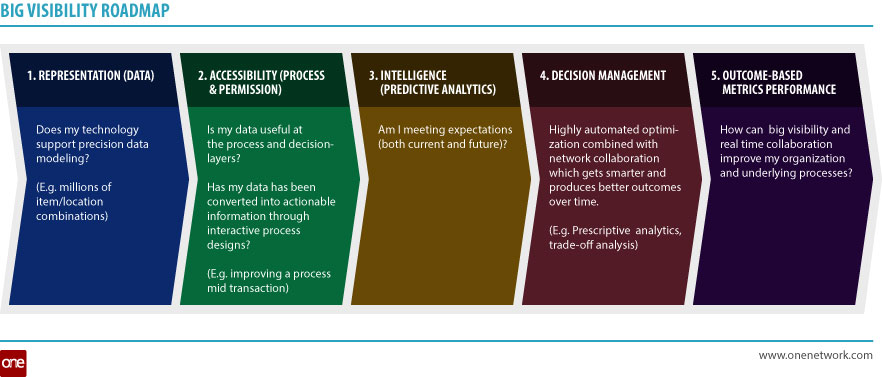This post has already been read 22986 times!
 In recent weeks, we’ve learned about supply chain’s biggest buzzwords, “big data” and “end to end” visibility,and why outsourcing your supply chain makes the big data problem worse. We’ve seen that they are actually related, and that achieving end-to-end visibility means overcoming a big data problem, We’ve given this new capability a label, “big visibility”. We’ve also discussed how supply chain is a lot like chess, and how we all need to approach our problems like grandmasters.
In recent weeks, we’ve learned about supply chain’s biggest buzzwords, “big data” and “end to end” visibility,and why outsourcing your supply chain makes the big data problem worse. We’ve seen that they are actually related, and that achieving end-to-end visibility means overcoming a big data problem, We’ve given this new capability a label, “big visibility”. We’ve also discussed how supply chain is a lot like chess, and how we all need to approach our problems like grandmasters.
So let’s assume that you too agree that big visibility is something worth striving for, the question now is, how do you get there? What follows is a 5 stage maturity model that may be useful to organizations as a roadmap. Each stage of maturity offers its own unique challenges (and benefits). As you read through the stages, think about how it applies to your own organization…do you recognize any of these stages?
Stage #1: Representation (Data)
The first step toward big visibility is merely representing the supply chain’s data. With the advent of big data, representation has changed forever. It is no longer necessary to limit representative data in the supply chain based on traditional system or technology constraints. Advances such Hadoop based architecture and horizontal grid computing enable organizations to represent data with an unprecedented amount of flexibility and scalability.
Stage #2: Accessibility (Process and Permission)
The second stage of big visibility is accessibility, and here real time process automation and management have changed the game. In traditional architectures, accessibility is somewhat synonymous with integration, universal object definitions, and longevity. However new architectures provide a real time business process management layer which in turn provides full control and interaction while executing a transaction – through state change and tracking event linkages. And not only is the data accessible, but through advanced process capabilities including policy and permission control, accessibility to big data now generates huge value at the process and decision-making layers.
Stage #3: Intelligence (Predictive Analytics)
Successfully achieving big visibility’s representation and accessibility stages will spawn a new and more responsive set of processes and policies. Companies now have the opportunity to generate a higher level of intelligence by comparing the incoming process data to their expectations of both the process’ performance itself as well as the process’ outcomes. Intelligence is all about knowing where a company is versus where it wants to be. Predictive analytics play a key role at this stage.
Stage #4: Decision Management(Prescriptive Analytics)
Ultimately, big visibility intelligence (Stage 3) is useless unless a company can interrupt a business decision point in a process and create a measurably different outcome. It’s amazing how many implementations stop at the intelligence stage and just push that data into a data warehouse or business intelligence portal. The reason of course is that the architecture isn’t designed for the big visibility accessibility or process automation (Stage 2) that was described earlier. In the decision management stage, companies can take their newly discovered intelligence and interrupt transactions and processes at either state transitions or by tagging tracking events. Once their intelligence shows an exception to their expected performance exists, they can then invoke a number of methods to manage this exception, both with automated routines and human intervention andcollaboration. These methods include prescriptive analytics, optimization, and trade-off analysis.
Stage #5: Outcome-Based Metrics and Performance
Achieving representation, accessibility, intelligence, and decision management enables the highest form of big visibility—outcome-based metrics and performance. A necessary outcome of our evolving supply chain networks will be to make sure we place the right assets in the right place at the right time in the right amounts, all bound by real time collaboration and big data visibility. Included in this evolution will be simultaneous efforts focused on organizational change, process reengineering, and lean/six sigma program management.
As Michael Porter proved in his work on market competition, the choice for any company to remain on the fence in terms of adjusting strategy based on foreseeable market shifts will result in ultimate business failure. Think about the typical supply chain infrastructure. Structured integration and communication vehicles like EDI aren’t going away, but the ability of the traditional supply chain design to react and respond, given all the information and lead time delays both upstream and downstream, is simply not competitive. The frequency and fidelity of available data across our demand/supply ecosystem is growing at a geometric rate. This data is an incredible asset and based on some of the clients I’ve worked with here at One Network, when this data is leveraged against an advanced supply chain network deployment it has the potential to drive up to a 4% increase in sales, a 10% reduction in operating expense, and a 30% reduction in inventory!
- Map of U.S. Trucking Spills in 2016 - January 13, 2017
- What is aPaaS? A Way to Supercharge Your App Development - December 12, 2016
- Future of Transportation: Goodyear’s Radical Smart Tire Concept - November 3, 2016

